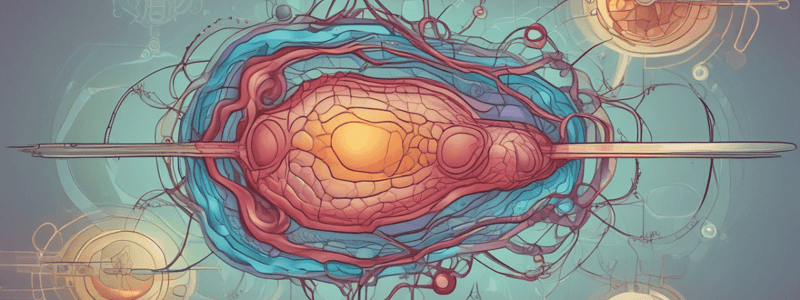Podcast
Questions and Answers
What is the main function of Phosphatidilcholine in the body?
What is the main function of Phosphatidilcholine in the body?
- Nervous transmission as a acetylcholinesterase
- Cell signaling
- Programmed cell death
- Source of methyl groups needed for many steps in metabolism (correct)
What is the name of the enzyme that is feedforward activated by citrate and inhibited by feedback inhibition of fatty acids?
What is the name of the enzyme that is feedforward activated by citrate and inhibited by feedback inhibition of fatty acids?
- Biotin dependent enzyme ACC (correct)
- Fatty acid synthase
- Decarboxylase
- Carboxylase
What is the term for the process of fatty acid synthesis?
What is the term for the process of fatty acid synthesis?
- Fatty acid degradation
- Fatty acid elongation
- Lipogenesis (correct)
- Lipolysis
What is the primary location where lipogenesis occurs?
What is the primary location where lipogenesis occurs?
What is the general property of lipids?
What is the general property of lipids?
What is the term for the lipids that are widely distributed in every tissue of the body, particularly in nervous tissue?
What is the term for the lipids that are widely distributed in every tissue of the body, particularly in nervous tissue?
What is the term for the main lipid constituents of membranes?
What is the term for the main lipid constituents of membranes?
What is the primary function of lipids in the body?
What is the primary function of lipids in the body?
What is the name of the phospholipid involved in cell signaling?
What is the name of the phospholipid involved in cell signaling?
Which of the following is NOT a function of lipids?
Which of the following is NOT a function of lipids?
What is the term for lipids that contain one double bond?
What is the term for lipids that contain one double bond?
What is the characteristic of fatty acids?
What is the characteristic of fatty acids?
Which of the following is a type of complex lipid?
Which of the following is a type of complex lipid?
What is the primary function of insulin in relation to ACC?
What is the primary function of insulin in relation to ACC?
What is the primary source of energy in lipids?
What is the primary source of energy in lipids?
What is the cofactor of fatty acid biosynthesis?
What is the cofactor of fatty acid biosynthesis?
Which of the following diseases is related to lipid metabolism?
Which of the following diseases is related to lipid metabolism?
What is the end product of fatty acid synthase activity?
What is the end product of fatty acid synthase activity?
What is the term for lipids that are combined with proteins in the blood?
What is the term for lipids that are combined with proteins in the blood?
Where does the further elongation of fatty acid chains occur?
Where does the further elongation of fatty acid chains occur?
What is required for desaturation reactions in the SER?
What is required for desaturation reactions in the SER?
How many carbon atoms are added to the growing fatty acid chain in each cycle?
How many carbon atoms are added to the growing fatty acid chain in each cycle?
What is the role of fatty acid synthase (FAS)?
What is the role of fatty acid synthase (FAS)?
What is unique about the brain's elongation capabilities?
What is unique about the brain's elongation capabilities?
What is the typical number of cycles performed to produce palmitic acid?
What is the typical number of cycles performed to produce palmitic acid?
Flashcards are hidden until you start studying
Study Notes
Lipid Metabolism Overview
- Lipids are non-polar, hydrophobic compounds that are insoluble in water but soluble in organic solvents.
- Lipids include fats, phospholipids, sterols, and others, serving as a concentrated source of energy (1g = 9.3 kcal).
- Lipids play a role in thermoregulation, absorption of fat-soluble nutrients, and as structural components of cells and subcellular components.
Classification of Lipids
- Simple lipids: acylglycerols, waxes
- Complex lipids:
- Phospholipids: glycerophospholipids, sphingophospholipids
- Glycolipids
- Sterols: cholesterol, hormones, vitamins, bile acids
- Lipid derivatives: eicosanoids, polyisoprenoids, ketone bodies
Fatty Acids
- Fatty acids are aliphatic carboxylic acids, typically occurring in the body as esters in natural fats and oils.
- Fatty acids usually contain an even number of carbon atoms and can be saturated or unsaturated.
- There are two types of unsaturated fatty acids: monounsaturated (one double bond) and polyunsaturated (two or more double bonds).
Glycerophospholipids
- Glycerophospholipids are amphipathic, consisting of alkyl chains with a terminal carboxyl group.
- Phospholipids are the main lipid constituents of membranes.
- Examples of phospholipids include:
- Phosphatidylcholine (a source of choline and involved in nervous transmission)
- Phosphatidylethanolamine (cephalin)
- Phosphatidylserine (plays a role in apoptosis)
- Phosphatidylinositol (involved in cell signaling)
- Cardiolipin (diphosphatidylglycerol, a major lipid of mitochondrial membranes)
Cholesterol
- Cholesterol is a sterol, an important lipid component of cell membranes.
Fatty Acid Synthesis (Lipogenesis)
- Fatty acid synthesis occurs primarily in the liver and lactating mammary glands, and to a lesser extent in adipose tissue.
- Lipogenesis uses ATP and NADPH and is a totally cytosolic process.
- The synthesis of fatty acids involves the repeated addition of two-carbon units from malonyl-CoA to a growing fatty acid chain.
- The process is catalyzed by a multi-enzyme complex called fatty acid synthase (FAS) and involves several enzymatic reactions, including condensation, reduction, dehydration, and reduction.
- Acyl carrier protein (ACP) is a cofactor of fatty acid biosynthesis.
- Palmitic acid (16:0) is the primary end product of fatty acid synthase activity.
- Fatty acid chains can be further elongated by the addition of two-carbon units in the smooth endoplasmic reticulum (SER).
- Desaturation of fatty acid chains occurs in the SER, requiring NADH, cytochrome b5, and its FAD-linked reductase.
Studying That Suits You
Use AI to generate personalized quizzes and flashcards to suit your learning preferences.




